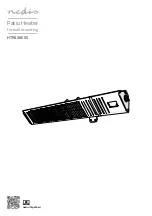
Maintenance Manual
49
49
GB
Maintenance
1. Safety recommendations
• This appliance is not designed to be used by anyone (including children) whose phy-
sical, sensory or mental capabilities are reduced or by inexperienced people unless
they are being supervised by someone responsible for their safety or they have been
instructed in advance in how to use the appliance.
• Children should be supervised to ensure that they do not play with the appliance.
2. Water heater maintenance
It is essential to cut all electrical power to the appliance before
opening the cover.
2.1 Domestic maintenance
Prevention
A water heater needs little domestic maintenance by the user:
• Operate the safety unit once or twice a month to remove any scale deposits and
make sure it is not blocked.
• Periodically check the lamp is working, by helping you to the Troubleshooting Table
section, page 54. If it stops or is flashing green rapidly, contact your installer.
• If a problem arises, the appliance doesn’t heat or steam is released at tapping
points, turn off the power and contact your installer.
To keep your appliance in good working order for many years, you need to have the
equipment checked by a professional every two years
Draining
In regions where the water is very hard (Th>20°f), you are advised to treat it. With
a softener the hardness of the water should remain above 15°f. The softener has
no adverse effect on our guarantee, as long as it is CSTB-approved for France and
adjusted according to good practice, regularly checked and maintained:
• Decree no. 2001-1220 of 20 December 2001 and circular DGS/SD 7A.
• Decree no. 2002-571 of 25 November 2002.
• Complies with DTU 60,1.
Proceed as follows when you want to drain your water heater (operation necessary
for descling or if the heater must remain out of operation in a room in which frost is
possible) :
1. switch the electricity power supply off
2. close the cold water inlet
3. open a hot water tap or loosen the hot water fitting.
4. open the safety valve drain tap
5
Manuel d’utilisation
FR
3. La commande nomade
3.1 Vérifications préalables
Charge de l’accumulateur
Le chauffe-eau doit être mis sous tension pendant au moins seize heures
en continu pour pouvoir recharger l'accumulateur assurant la transmis-
sion vers la commande nomade.
Dans le cas d'une double tarification (heures creuses / heures pleines),
utiliser le contacteur du chauffe-eau pour le mettre en marche forcée.
Si l'accumulateur n'est pas suffisamment chargé, la communication radio
peut connaître des coupures
Installation des piles sur la commande nomade
S'assurer que les piles sont bien installées dans la commande nomade.
Voir le paragraphe Mise en place des piles, page 40.
Réglage date et heure
Vérifier le réglage du jour et de l'heure en appuyant sur la touche
Voir le paragraphe Réglage du jour et de l’heure, page 42.
Un mauvais réglage du jour et de l'heure peut engendrer un
dysfonctionnement du chauffe-eau.
Une fois ces vérifications réalisées, vous pouvez procéder à la mise en
place de la commande nomade.
Manuel utilisation FR.book Page 5 Mercredi, 23. décembre 2009 11:32 11
















































